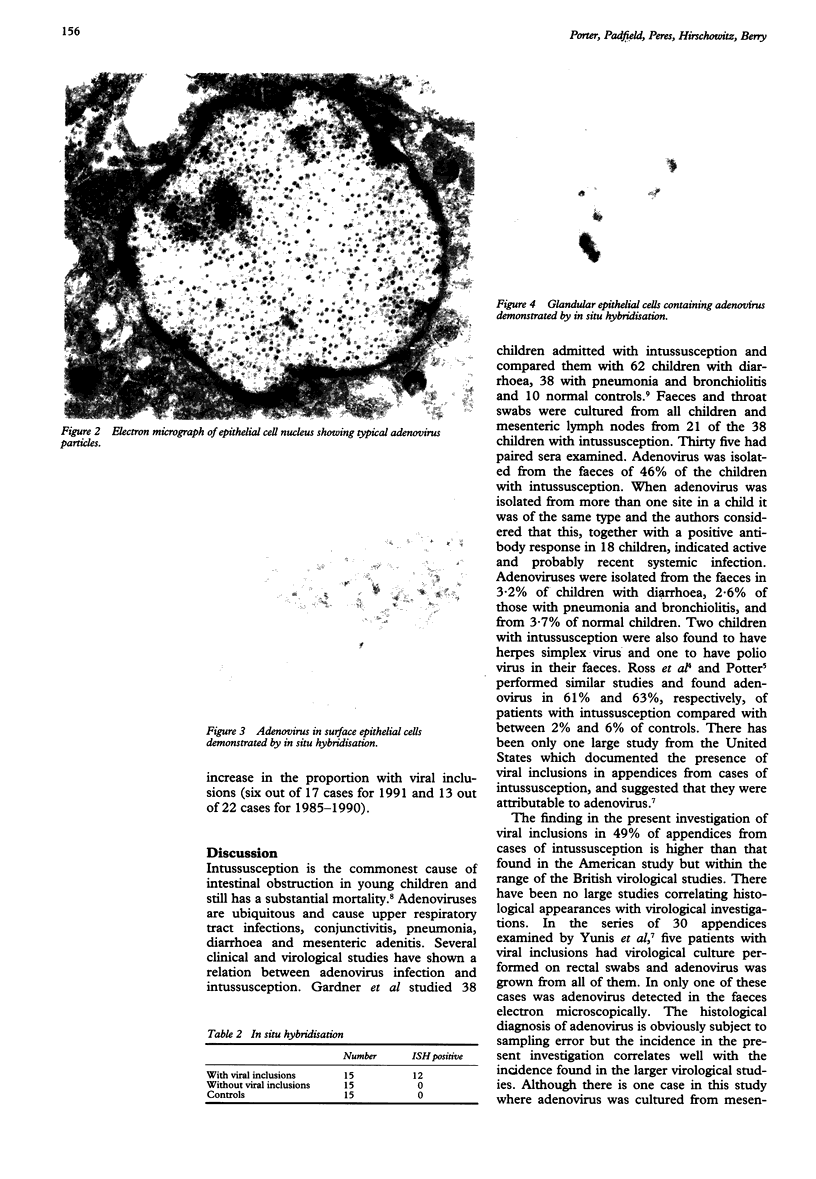Abstract
AIMS: To examine the light and electron microscopic features of appendices removed at the time of surgical reduction of intussusception in children; and to confirm that the viral inclusions seen in some of them are due to adenovirus. METHODS: A series of 39 appendices from cases of intussusception and 15 control appendices were reviewed. Light microscopic examination of haematoxylin and eosin stained sections was performed on all of them and one appendix with large numbers of inclusions was examined by electron microscopy. Non-isotopic in situ hybridisation using a biotinylated DNA probe was carried out on sections of appendix from 30 of the cases of intussusception and from the 15 controls. RESULTS: Light microscopic examination showed viral inclusions in 19 of the appendices from the cases of intussusception and in none of the controls. Electron microscopic examination showed viral particles with the typical features of adenovirus. Most of the appendices with viral inclusions in the haematoxylin and eosin stained sections also contained adenovirus DNA as shown by in situ hybridisation. CONCLUSIONS: Viral inclusions seen in appendices from cases of intussusception are caused by adenovirus. Adenovirus DNA was not demonstrable in appendices from cases of intussusception without viral inclusions and the aetiological factors involved in intussusception in these children remain unknown.
Full text
PDF




Images in this article
Selected References
These references are in PubMed. This may not be the complete list of references from this article.
- Asano Y., Yoshikawa T., Suga S., Hata T., Yamazaki T., Yazaki T. Simultaneous occurrence of human herpesvirus 6 infection and intussusception in three infants. Pediatr Infect Dis J. 1991 Apr;10(4):335–337. [PubMed] [Google Scholar]
- BELL T. M., STEYN J. H. Viruses in lymph nodes of children with mesenteric adenitis and intussusception. Br Med J. 1962 Sep 15;2(5306):700–702. doi: 10.1136/bmj.2.5306.700. [DOI] [PMC free article] [PubMed] [Google Scholar]
- Konno T., Suzuki H., Kutsuzawa T., Imai A., Katsushima N., Sakamoto M., Kitaoka S., Tsuboi R., Adachi M. Human rotavirus infection in infants and young children with intussusception. J Med Virol. 1978;2(3):265–269. doi: 10.1002/jmv.1890020310. [DOI] [PubMed] [Google Scholar]
- Lopez E. L., Devoto S., Woloj M., Pickering L. K., Cleary T. G. Intussusception associated with Escherichia coli O157:H7. Pediatr Infect Dis J. 1989 Jul;8(7):471–473. [PubMed] [Google Scholar]
- Nicolas J. C., Ingrand D., Fortier B., Bricout F. A one-year virological survey of acute intussusception in childhood. J Med Virol. 1982;9(4):267–271. doi: 10.1002/jmv.1890090404. [DOI] [PubMed] [Google Scholar]
- POTTER C. W. ADENOVIRUS INFECTION AS AN AETIOLOGICAL FACTOR IN INTUSSUSCEPTION OF INFANTS AND YOUNG CHILDREN. J Pathol Bacteriol. 1964 Jul;88:263–274. [PubMed] [Google Scholar]
- ROSS J. G., POTTER C. W., ZACHARY R. B. Adenovirus infection in association with intussusception in infancy. Lancet. 1962 Aug 4;2(7249):221–223. doi: 10.1016/s0140-6736(62)92315-2. [DOI] [PubMed] [Google Scholar]
- STRANG R. Intussusception in infancy and childhood; a review of 400 cases. Br J Surg. 1959 Mar;46(199):484–495. doi: 10.1002/bjs.18004619917. [DOI] [PubMed] [Google Scholar]
- Stringer M. D., Pledger G., Drake D. P. Childhood deaths from intussusception in England and Wales, 1984-9. BMJ. 1992 Mar 21;304(6829):737–739. doi: 10.1136/bmj.304.6829.737. [DOI] [PMC free article] [PubMed] [Google Scholar]
- Yunis E. J., Atchison R. W., Michaels R. H., DeCicco F. A. Adenovirus and ileocecal intussusception. Lab Invest. 1975 Oct;33(4):347–351. [PubMed] [Google Scholar]






